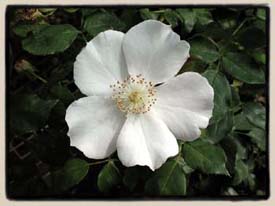 |
|
Albas |
My Favorite New Roses This Season, Part Three
Like most of the Multiflora Ramblers, this is a large plant, growing to a height of ten to twenty feet. The canes are lax and easily manipulated to flow over an arch or cling to a pillar. If we could say this rose has any drawbacks, it would be the fact that it blooms once a season for a few weeks in late spring. However, many people overcome this aspect by planting Clematis at the base where it can climb into the rose and provide bloom after the rose is finished.
Sequoia Nursery, who introduced this rose in 1993, lists it as a Miniature, but since it will easily grow to 2.5 by 2.5 feet, I think it is more of a Patio/Floribunda sort. Individual blooms are about 1.5 to 2 inches across, and fully double. There is the same peculiar fragrance as its parent, which reminds me of the maroon Trilliums in spring! This has been a terrific performer after settling in for a year, as it is never without a few blooms. The color is magnificent, and the compact, rounded shrub habit is most attractice. I recommend it highly. Thanks, Kim, for a very unique rose!
I have admired 'Geoff Hamilton' in the gardens of Heirloom Roses in St. Paul for a couple of years now, before it was listed as a named variety. It is a full, shrubby plant of 4 to 5 feet tall, producing large cupped blooms in clusters. Individual blooms are about 4 inches across, and are the softest warm pink which does not fade too quickly. I think these cupped, full blooms come the closest to my personal idea of the perfect English rose. There is a very pleasant scent when blooms are fresh, but the fragrance seems to dissipate too soon. I look forward to watching this one mature, and I will report on its progress. I should mention that Mr. Geoff Hamilton was a television gardeneing personality who passed away in 96. His legacy is the Barnsdale Gardens which he created in England.
Introduced by Robert & Moreau in 1858, 'Homère' is considered to be one of the hardier of the Teas, and certainly one of the best overall performers. It will quickly form a shrub of about 3 by 3 feet, and is a good choice for a large patio pot or tub. Blooms are produced singly on the ends of twiggy branches, and are very nicely scented, of Tea, of course! Each blossom is about 2.5 to 3 inches across...not large for its class, but very nice just the same. The word pretty seems to truly describe such a rose as this, for it is a subtle and lovely coloring. Whenever I see it in bloom, I think to myself, "this is Double Delight for the 1800's!" It's a fine little rose with a graceful, understated charm that deserves to be grown more often. Keep in mind that it is not likely hardy below USDA zone 7.
This compact little rose has an excellent growth habit, inherited in part from its Tea parent. It has beautiful dark green foliage that stays clean and healthy, and is well branched, producing clusters of a dozen or more blooms on a stem, opening in succession. Each bloom is about 2.5 to 3 inches across, and pure gleaming white. It has been compared to 'Sally Holmes', but in many ways, it is a nicer rose of more compact and mannerly growth. The only thing missing is fragrance, but then you can't have everything! I adore this little rose for its simplicity and purity. If you are interested in learning more about Ralph Moore and his work, and hearing the latest news about his breeding program, you should consider subscribing to his newsletter, "Minirama". It is produced quarterly and can be obtained by sending $6, US to Sequoia Nursery, 2519 East Noble Avenue, Visalia California. 93292. Be sure to write "Attention: Minirama" on the envelope. You might want to consider joining the Yahoo discussion list, "GrowRoses", where over 350 Rosarians come to talk and share their experiences and expertise with Roses. Email the list owner to join by clicking on the "chat" link on their home page. (click on this text to get to the home page) Here is a list of suppliers for the roses listed in this article: Return to Part One of this article Return to Part Two of this article
Original photographs and site content © Paul Barden 1996-2003 |
|||||||||||||||||||

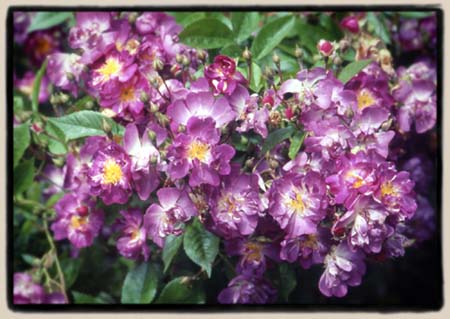 This
next rose almost needs no introduction. 'Veilchenblau' is famous
as the "Blue Rambler", because of its cool, greyish
mauve coloring. There are few roses of this wonderful color, either
modern or ancient. I am especially fond when the blooms begin fading,
and they turn a wonderful slatey-grey hue! Naturally, being a R.
multiflora hybrid, 'Veilchenblau' has a great fragrance;
sweet and pervasive that floats on the breeze for a great distance.
Individual blooms are about an inch across, but they are produced in
great clusters of thirty or more.
This
next rose almost needs no introduction. 'Veilchenblau' is famous
as the "Blue Rambler", because of its cool, greyish
mauve coloring. There are few roses of this wonderful color, either
modern or ancient. I am especially fond when the blooms begin fading,
and they turn a wonderful slatey-grey hue! Naturally, being a R.
multiflora hybrid, 'Veilchenblau' has a great fragrance;
sweet and pervasive that floats on the breeze for a great distance.
Individual blooms are about an inch across, but they are produced in
great clusters of thirty or more.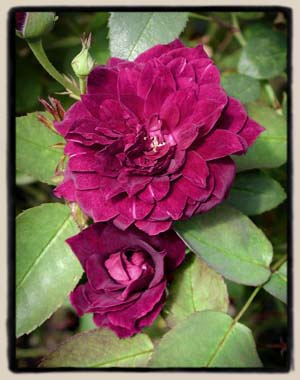 'Purple
Buttons' is a very interesting Patio sized rose that I have had
for a year now. It was bred by a friend of mine in California,
'Purple
Buttons' is a very interesting Patio sized rose that I have had
for a year now. It was bred by a friend of mine in California, 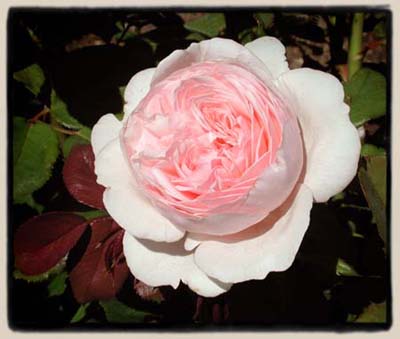 Usually
every year I add one of David Austins newer roses to my garden, and
this year the only one I have added is
'Geoff Hamilton' Like many
people, I am starting to feel there is some redundancy in the English
roses, with only small improvements or style changes with each new variety.
I wish Mr. Austin would make some "lateral moves" in his breeding
work. This is not to say that I don't have a deep appreciation for some
of his roses! I think that some of the pinks are exquisite; roses like
'
Usually
every year I add one of David Austins newer roses to my garden, and
this year the only one I have added is
'Geoff Hamilton' Like many
people, I am starting to feel there is some redundancy in the English
roses, with only small improvements or style changes with each new variety.
I wish Mr. Austin would make some "lateral moves" in his breeding
work. This is not to say that I don't have a deep appreciation for some
of his roses! I think that some of the pinks are exquisite; roses like
'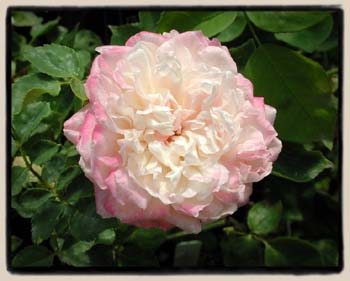 I
am beginning to discover some of the beautiful older
Tea roses from the 1800's, and 'Homère' is one of the more recent
ones I have come to know. (Don't confuse this rose and its class with
the Hybrid Teas, which came much later as offspring of the true Teas)
I
am beginning to discover some of the beautiful older
Tea roses from the 1800's, and 'Homère' is one of the more recent
ones I have come to know. (Don't confuse this rose and its class with
the Hybrid Teas, which came much later as offspring of the true Teas)
